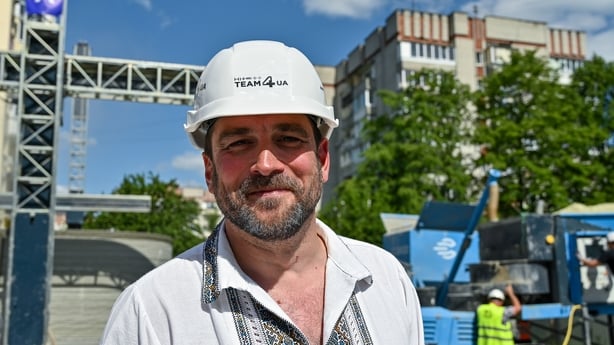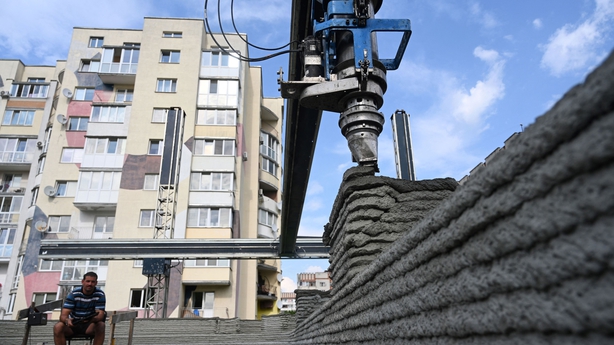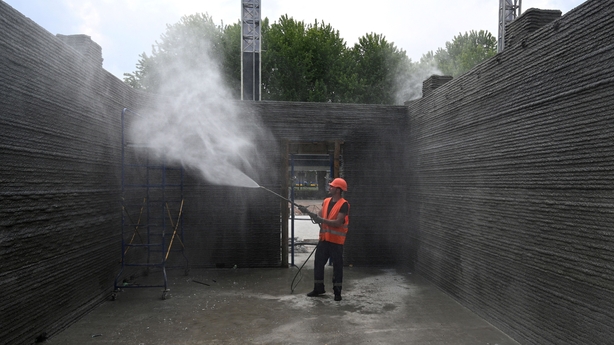Jean-Christophe Bonis, a self-described "futurist", has forged a career as a tech entrepreneur and advocate for the use of AI and robotics in sustainable projects.
One week after Russia's invasion of Ukraine, the Frenchman founded Team4UA, a charity to provide tech solutions to alleviate the massive humanitarian crisis facing the country.
"We are now 150 people on the ground with three programmes. I think we are one of the biggest Ukrainian charities on the ground, working with United Nations and many other partners worldwide," said Mr Bonis, speaking to RTÉ News from Lviv, western Ukraine.
In the early months of the war, between 75,000 to 100,000 internally displaced refugees were constantly passing through Lviv, many staying for longer periods of time.
Mr Bonis proposed a novel solution to the mayor of Lviv to accommodate the refugees.
"My immediate reaction with the mayor was: 'why are you not printing the buildings to be able to host these people?'"
"I told him 'look, give me land where I can print a school and I will show you it's possible, and my foundation will give a school to the city hall,'" said Mr Bonis.

A site was identified next to School 23 in Lviv. Before the war, the school taught approximately 800 pupils.
Today, 1,200 pupils attend the school, said Mr Bonis, many of whom have been displaced from elsewhere in Ukraine due to the war.
Mr Bonis approached Danish 3D-printing developers COBOD, which provided its BOD2 printer.
The robot, which measures 15 metres in length and 12 metres in width, prints using concrete.
Three trucks were used to transport the 3D printer from Denmark to Ukraine.
Printing work on the 506 square metre school, the largest of its kind in the world according to Mr Bonis, began in mid-May. Construction is expected to be completed by the end of next week.
It will be Ukraine's first 3D printed building. Designed by Kyiv architectural firm Balbek Bureau, it will accommodate 100 pupils.
"I want to use local material, local operators and concrete," said Mr Bonis.

On site, three engineers from 3DCP Group, a Danish 3D printing firm, are overseeing printing, and training ten local Ukrainian staff to use the printer.
"It’s a project that's very hard to say no to when someone asks you if you want to build a school in a war-torn country," Mikkel Brich, CEO of 3DCP Group said.
Mr Brich, speaking from the printing site, said that it takes the robot three days to print three metre high walls for a 140 square metre section of the building.
"We have no architectural limitations. It's the same cost for the printer to do a straight wall, as it is to do a round wall or curvy wall. A masonry crew would have no chance to keep up with the technology."
The robot being used in Lviv can print structures up to three storeys in height, as well as the walls and the roof.

However, human builders will still be needed to fit doors, heating systems, paint the walls and complete other fine details.
That next stage will take another couple of months to complete, said Mr Bonis, and the school is expected to open in January 2024.
Team4UA has budgeted the total cost of the project at $800,000, and Mr Bonis said he is trying to raise funds to complete the work.
The French entrepreneur believes that AI and robotics can provide a solution to Ukraine's reconstruction efforts. He already has his sights on his next project: 3D printing a bridge in the Kherson region of southern Ukraine.
Kherson was occupied by Russian forces for the first nine months of the war, and continues to be shelled by Russia on a daily basis.
"These two pilots are helping me to show that we can print infrastructure and solve the problematic of construction and the speed of reconstruction in Ukraine now," said Mr Bonis.







